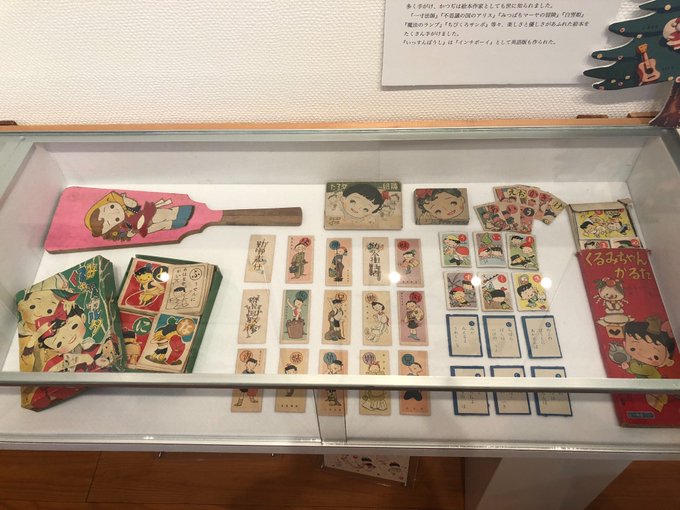Long before Hello Kitty and Rilakkuma, there was little Kurumi-chan, lending her cuteness to transform everyday objects into must-have items. Considered one of the first kawaii character icons, Kurumi-chan made her debut in 1938 as the bubbly and cheerful protagonist of the manga Kurukuru Kurumi-chan by Katsuji Matsumoto. Initially published in the popular girls’ literary magazine, Shojo no Tomo, Kurukuru Kurumi-chan featured the everyday adventures of the cute and precocious young girl named Kurumi (translated as ‘walnut’ in Japanese). While the story itself was quite simple, the manga soared in popularity and Kurumi-chan quickly became a much-loved character among girls across Japan.

Kurumi-chan’s sweet and energetic personality along with the manga’s lighthearted and cheerful atmosphere made Kurumi-chan a natural addition to everyday items used by young girls. Goods featuring her image including paper dolls, stickers, stationary goods, and even karuto playing cards became quite popular in the late 1930s, even as the war effort was ramping up. During the war, Kurumi-chan was even a popular motif for postcards designed to encourage Japanese troops. I’m sure in the years surrounding the war, Kurumi’s cheerful innocence provided a sense of hope, joy, and a momentary escape during those turbulent times.

The manga’s initial run only lasted for a of couple years before being halted in 1940 due to the war. It wasn’t revived until 1949 in the magazine Shojo under the title ‘Kurumi-Chan’ where it continued until 1954. Despite this long hiatus in publication, Kurumi-chan herself never fell out of the public eye and goods featuring her image continued to remain popular. Her popularity even with the lack of a running manga suggests that the main way fans connected with Kurumi-chan was through her merchandise rather than her comic, similar in the way that current kawaii characters such as Hello Kitty and Rilakkuma are icons that exist outside of a story narrative.

In the initial prewar comic, Kurumi-chan resembled a girl of around 9 or 10. Over time however, her character evolved and she came to be depicted as a much younger girl of just 5 or 6. This later image of Kurumi-chan featured many of the exaggerated characteristic that have now come to be standard with Japanese kawaii characters; such as an over-sized rounded head, low wide-set eyes, short and chubby limbs, cute hand gestures. Add in the simple bell dress and ribbon in her hair and this brings to mind Japan’s most famous kawaii character, Kitty-Chan.

Kurumi-chan’s character design and also many of the artistic techniques employed by Katsuji in his manga show a clear influence of American comics popular in the 1920s and 30s as well as other American characters such as Campbell Kids and Rose O’Neill Kewpies, which were quite popular in Japan at the time. A more in-depth review regarding the influences of western comic on Kurumi-chan character designs and Katsuji’s manga is discussed in more detail in this excellent post by Ryan Holmberg in The Comics Journal Blog: http://www.tcj.com/matsumoto-katsuji-and-the-american-roots-of-kawaii/
In addition to creating Japan’s first kawaii goods character, Katsuji Matsumoto is also credited with being one of the early founders of shojo manga. Katsuji was frequent illustrator and manga artist for Shojo no Tomo and other popular girl’s magazine throughout the 1930s and was lauded for his bright and cheerful characters, humorous storytelling, and novel illustrative techniques. One of his early comics, The Mysterious Clover, published in 1934 in Shojo no Tomo is considered a pioneer work in early Shojo manga not only for its main character, a spunky tomboy always looking for adventures, but also for its use varying perspectives and variations in the panels sizes.

Following the successes of Kurumi-chan, Katsuji retired from his career as a manga artist in 1955. A few years after retirement he founded a baby’s merchandise company called Katsu Production in 1960. Katsuji continued to be active in illustrating and product design until his death in 1986. If you happen to be in Japan, you can check out his work at Katsuji Matsumoto Gallery in Tokyo managed by his surviving children. Additionally, Illustrations and goods designed by Katsuji continue to be displayed in various temporary exhibitions at galleries and museums around the country and you can find postcards and goods featuring his designs on various Japanese auctions sites.

Check out these link’s for additional info on Katsuji and his lasting kawaii legacy:
- http://katsudi.com/
- http://www.tcj.com/the-mysterious-clover-matsumoto-katsuji-douglas-fairbanks-and-the-reformed-modern-girl/2/
